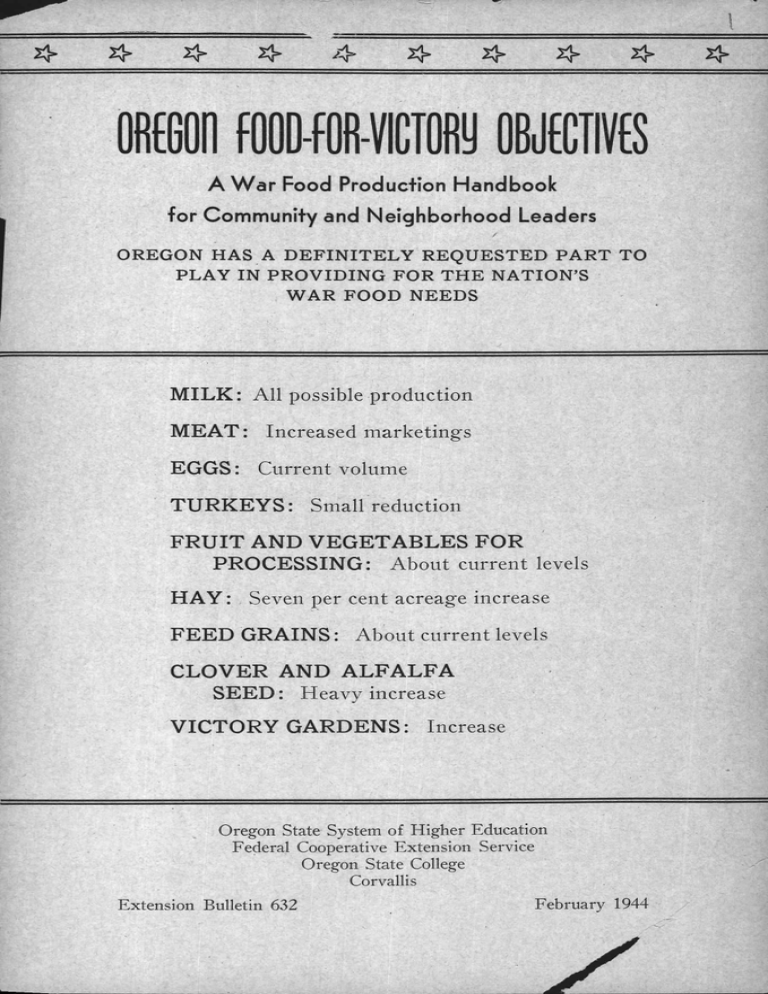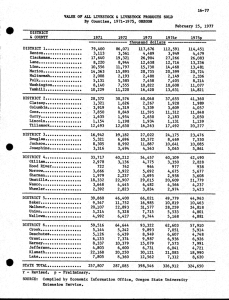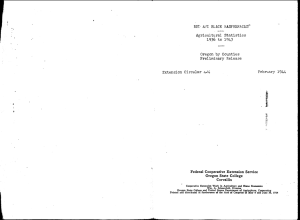* 0E011 fOOD-fOR-VICTORY OBJECTIVES
advertisement

* * * * * * * * * 0E011 fOOD-fOR-VICTORY OBJECTIVES A War Food Production Handbook for Community and Neighborhood Leaders OREGON HAS A DEFINITELY REQUESTED PART TO PLAY IN PROVIDING FOR THE NATION'S WAR FOOD NEEDS MILK: All possible production MEAT: Increased marketings EGGS: Current volume TURKEYS: Small reduction FRUIT AND VEGETABLES FOR PROCESSING: About current levels HAY: Seven per cent acreage increase FEED GRAINS: About current levels CLOVER AND ALFALFA SEED: Heavy increase VICTORY GARDENS: Increase Oregon State System of Higher Education Federal Cooperative Extension Service Oregon State College Corvallis Extension Bulletin 632 February 1944 * farmer in the United States has been asked to assist in His contribution is increased production, based on such adjustments as his management plans will permit, to add greater total volume to certain EVERY an enlarged wartime food production program. particularly needed commodities. After two years it is desirable that every farmer know the accomplishments attained and the part his state and county have played in reaching them. Increased production has been achieved. In 1942 it was 125 per cent of 1935-39 prewar average. In 1943, it was 127 per cent. Demand for farm products nevertheless continues to increase. The armed forces grow in numbers, and men in service consume more food per capita than in peace times. There are losses of food in transportation and on battle fronts. Demand for food products from the Allies is increasing. Domestic demand per capita has increased because of heavy employment at substantial wages. The Government request for 1944, therefore, is for even greater farm production involving increases in crop acreages from 364,000,000 acres in 1943, up to 380,000,000 acres in 1944, which, if weather conditions are normal, will bring total food production to 130 per cent of the 1935-39 average. Present weather conditions point to less favorable conditions than in recent years. TO PROVIDE ADEQUATE MILITARY AND DOMESTIC FOOD SUPPLIES This volume, if attained, should provide for increased supplies anticipated for the armed forces and the Allies and maintain current domestic volume at about last year's levels. These levels are generally adequate, notwithstanding temporary scarcity of some products in localized areas and a somewhat general shortage of butter and other edible fats and oils. The proposed 1944 allocations for domestic purposes are the same for meat, practically the same for eggs, greater for milk, somewhat less for butter and other fats and oils, and canned vegetables. Allocations for military purposes are largest in terms of percentages of total production in the case of canned fruits and fruit juices, at 34.8 per cent. Second, are canned vegetables, 20.7 per cent. Sixteen and three-tenths per cent of the country's butter output, and 16.1 per cent of the meat supply are allocated to military use in 1944. Lend-lease allocations, in percentage of total production, are highest in edible fats and oils, other than butter, at 24.7 per cent. Meat allocations are second at 12 per cent. Butter is 3.1 per cent. Fruits and vegetables run from 3 to 5 per cent. Farmers in Oregon have made a substantial contribution to the nation's increased food supply. In 1943 the crop acreages harvested and livestock and poultry cared for exceeded all previous Oregon figures for the third successive year. Weather was favorable, labor difficulties were largely overcome, and crops and livestock marketed reached new volumes. Nevertheless, in line with increased production in the United States, Oregon farmers are asked to increase crop acreages of specified crops by about 151,000 to a total of 3,116,400 acres in 1944. Throughout the United States, increasing livestock numbers, including chickens and turkeys, have reached a point out of balance with the feed supply. National objectives are, therefore, a reduction in farm inventories of livestock and poultry and increased acreages of hay and some other feed crops. Objectives in 1944 for crop production in Oregon are as follows Per cent Commodity Corn, all Sugar beets, planted Irish potatoes, planted Beans, dry field, planted Peas, dry edible, planted Green peas for processing, planted Tomatoes for processing, planted Sweet corn for processing, planted Green beans for processing, planted Fresh vegetables, harvested Oats, planted Barley, all planted Wheat, all planted Rye for grain, harvested Flaxseed, planted Flax for fiber (capacity of processing plants) Hay, all tame, harvested Alfalfa for seed, harvested Red clover for seed, harvested Alsike for seed, harvested Hairy vetch for seed, harvested Other vetch for seed, harvested Crimson clover for seed, harvested Austrian peas for seed, harvested Ryegrass, common and perennial, for seed, harvested 1944 of 1943 1944 acreage goals 1943 Acres Acres Per cent 52,000 9,300 53,000 3,000 39,600 48,800 1,000 4,900 4,400 20,800 446,000 292,000 773,000 36,000 5,000 60,000 12,000 50,000 2,200 75,000 48,800 900 4,900 4,400 21,200 446,000 260,000 800,000 36,000 3,000 115 130 94 12,000 854,000 3,500 10,000 16,000 80,000 59,000 3,500 62,000 12,000 915,000 8,000 18,000 17,000 60,000 115,000 2,000 37,000 100 107 76,500 108,000 75 190 100 90 100 100 102 100 89 103 100 60 230 180 106 75 195 57 60 141 These objectives resulted from estimates suggested by the Government, harmonized with state conditions by staff members from the Oregon Agricultural Experiment Station and Extension Service. In every county in the state a meeting of farmers has been held to consider the acreages requested. The judgment of these farmers after estimating fall plantings and other factors indicated that Oregon farmers would probably attain approximately 97 per cent of the acreages suggested, although there was wider variation in some of the commodities. It appeared after assembling the estimates of the farmers in all the counties that wheat and other small grain production goals may be exceeded by about 65,000 acres. The acreage of hay may be about 60,000 acres under objectives established; and Austrian peas and vetch for seed will be about 60,000 acres under. Dry edible peas and potatoes, it was believed, also would fall short of the acreages suggested by 14,000 and 7,000 respectively. Of particular concern is opinion that the suggested 7 per cent increase in acreage of hay harvested may not be attained, as prospects indicated about the same acreage of hay as last year. Scarcity of snow in the mountains and consequent shortage of water for irrigation currently indicates that hay yields may be lighter than in recent years on this acreage. Desirable objectives in line with re-establishing balance between livestock and poultry, and feed supplies, and at the same time continuing maximum contributions to the war effort were established as follows : OREGON LIVESTOCK OBJECTIVES FOR 1944 January 1, 1945 Livestock numbers on farms January 1, 1945 All cattle and calves Cows, kept for milk, 2 years and over Other cows, 2 years and over All sheep and lambs Ewes, 1 year and over per cent of 984,000 260,000 230,000 1,270,000 1,000,000 1943 87 1 78 90 90 Per cent of Livestock production during 1944 Sows farrowed spring Sows farrowed fall Milk cowsaverage during year Milk producedpounds (all-out production) Chickens raised Commercial broiler production Turkeys raised Eggs produceddozen 1944 as of 1943* 41,000 30,000 250,000 1,348,000 5,900,000 300,000 1,917,000 40,000,000 Estimatedsome 1943 official figures are not yet available. 89 81 94 94 99 74 92 98 As in the country as a whole, Oregon livestock production has increased to a point quite seriously overbalancing available feed supplies. Increased hay production is first line insurance against pos- sible loss to the farmer and loss of meat and milk to the country. Maximum production of livestock and livestock products is not attained with short feed supplies. Because of the large acreage of Oregon crops seeded in the fall, extensive revision of crop acreage trends is not possible in late winter. Certain trends, however, may be influenced to a helpful degree. It is still possible to increase hay and corn acreages, and to diminish the marked trend toward increased wheat acreage by the substitution of other crops for spring wheat. Estimates of farmers indicated that these objectives, which in all cases were a reduction in numbers by January 1, 1945 under January 1, 1943, were not likely to be fully attained except in the case of swine where the reduction would be between 24 and 25 per cent lower than suggested. While the trend in the state was estimated as downward in all classes of livestock, several factors seem to prevent reducing to the point considered soundest from a longtime standpoint. Unstable marketing conditions are one factor ; a rather easy first half of the winter on feed supplies is another. Estimates of chickens raised point to lower production this year than the objectives sought, while a suggested decrease in turkeys raised, in the opinion of farmers, will not occur and numbers will be about the same as last year. The outlook for egg prices in 1944 is reasonably good, and the feed-egg ratio, while less favorable than last year, should be above the 10-year average. Any substantial reduction in laying flocks could easily lead to a shortage of eggs in the Pacific Northwest. This outlook should become stabilized if established producers maintain their laying flocks at about the same level, eliminate culls, and brood about the number of chickens suggested in the state objectives. 'Phere is a substantial increase in the number of turkey breeding stock in Oregon and also elsewhere in the country. This will no doubt reduce the demand for late hatching eggs and poults. In face of the present feed shortage, an increase in turkey production is hazardous, and would reduce available feed supplies for more needed milk and egg production. DAIRY ANIMALS REDUCED BECAUSE OF FEED SHORTAGE The country needs all-out milk production. The suggested inventory of dairy cows on January 1, 1945 is 91 per cent of those on farms on January 1, 1943 because of short feed supplies. Farmers predict about 6 per cent reduction instead of 9 per cent, mainly be- cause of inability in 1943, and perhaps in 1944, to market cull dairy stock. *iv Hog production was believed likely by the farmers to go considerably below the suggested objectives. It will be unfortunate if this reduction should extend too far. If the average production of 1931-41 is maintained, both long-time management plans and contribution to the war food supply will be at a point that is generally satisfactory. This position will be attained if farmers plan to continue hog production in line with the Oregon peacetime program. This program is to utilize dairy products, cull fruits, and vegetables, including low grade and cull potatoes and wheat in the stubble fields, the latter at the rate of about one hog for every five acres ; these waste products to be supplemented with grain. Outlook for supplies and equipment in 1944 is somewhat improved. Farm machinery will be available in increased volume but not in adequate supply to meet all demands. Insecticides and fungicides and fertilizers will be available in larger supply. Labor shortage appears no more serious, and experiences of the past two years should be helpful in increasing the distribution and effectiveness of available labor. The outlook is for continuation of a generally high price level, although it may be spotty. Price supports will be announced by the Extension Service as they are determined. Although a general high price level is in prospect, costs are increasing, and net returns' to farmers may not equal those of 1942 and 1943. The need for home gardens is as urgent as in 1943. Allocations to armed forces and Allies have priority, and unfavorable growing conditions could very easily cause a shortage of many processed foods available for domestic use. Farmers who grow gardens to take care of family needs are establishing insurance of adequate family diet and contributing to the war effort. Gardens should include supplies for fresh consumption and ade- quate volume for canning, dehydrating, freezing, and storage for winter needs. In addition to the weather hazard, shortages of tin and steel may become more acute, and on the West Coast particularly, increasing transportation difficulties are anticipated. The number of gardens grown on farms in Oregon last year is estimated at 55,000a greater number than ever before. But several thousand farms had no garden. A very desirable objective for 1944 is a garden on every farm in Oregon. In addition, every nonfarm family that can obtain land should have a garden. Home Production of all other possible items of the family food supply should be a part of every farm plan in 1944. Milk, eggs, meat, and fruit can be produced and in many cases processed for later use. Cooperative Extension Work in Agriculture and Home Economics Wm. A. Schoenfeld, Director Oregon State College and United States Department of Agriculture, Cooperating Printed and distributed in furtherance of the Acts of Congress of May 8 and June 30, 1914




